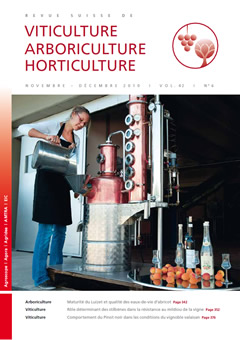
Issue 6 - November - December 2010
Abstract in open access
This project aimed to relate the ripening stage of apricot (cv. Luizet) at harvest and the chemical and sensory quality of the apricot distillates obtained. Results showed that a higher ripening of the apricots significatively enhanced ethanol yield and decreased methanol level in the distillates. In parallel, aromatic compounds profiles were established through electronic nose. These analyses evidenced various profiles, principally depending on the apricot ripening level and at a minor degree on the orchard location (valley and hillside). However, the prolongation of fruit ripening isn't illimited: a panel of 187 consumers globally preferred the distillates from apricots harvested at optimal ripening stage, then from over-ripe fruits and finally from unripe fruits. A multilinear correlation explained 64.7 % of the preferences of the panel considering the soluble solid content, the color and the firmness of the fruits.
Keywords: apricot, ripening stage, distillate quality, sensory
E-Mail: julien.ducruet@eichangins.ch
Adress:
Abstract in open access
Leaves of different Vitis vinifera L. cultivars, susceptible (Chasselas) or resistant to downy mildew (Solaris and 2091), as well as the immune Muscadinia rotundifolia were inoculated with Plasmopara viticola. Samples were examined by microscopy for their ability to synthesize toxic compounds towards downy mildew at infection sites (stilbenic phytoalexins). In the susceptible Chasselas, P. viticola completes its life cycle with the production of functional haustoria as the cultivar produces mainly the non toxic piceide. The development of downy mildew is different in each of the other three resistant grape cultivars. In Solaris and 2091, the development is stopped after the formation of haustoria and is correlated to the synthesis of respectively ?-viniferin and pterostilbene. In M. rotundifolia, downy mildew development stops immediately after germ tube penetration (without functional haustoria formation). Stilbenes are here produced exactly at the infection sites. Their concentration is at least 20 times higher than in the three other cultivars. The relevant role of stilbenes in mildew resistance of Vitis spp. is discussed.
Keywords: downy mildew, epifluorescence microscopy, grapevine, leaf, stilbenes, stomata, resistance, ultrastructure
E-Mail: katia.gindro@acw.admin.ch
Adress:
Abstract in open access
The understanding of the mechanical behavior of winegrapes during ripening and its impact on the release of anthocyanins is important for wine quality control. The characterization of the mechanical proprieties of grape berries appears to be an essential parameter for understanding grape ripening, owing to its key role regarding the main compounds responsible for wine quality such as anthocyanins. Nevertheless, few studies have been conducted on wine grape texture analyses. The evolution of the mechanical properties of Cabernet Franc grapes belonging to three different vineyards during ripening was studied by performing rheological tests (compression and puncture tests) and correlating these changes with their degree of ripeness and with skin anthocyanin extractability. Results show that differences in the easiness of anthocyanin extraction could be linked to differences in the mechanical behavior of berries and that the extraction yield of anthocyanins from grapes could be predicted by their rheological properties.
Keywords: ripening, compression, puncture test, anthocyanins extractability, grapes
E-Mail: f.jourjon@groupe-esa.com
Adress: Ecole supérieure d'agriculture d'Angers ESA, F-49007 Angers Cedex 01
Abstract in open access
The «terroir» concept in wine includes several dimensions: soil, territory, know-how, etc. This very complex notion needs to be clarified for most of the consumers. Wine professionals use this concept without knowing its real impact on consumers' perception. This work aimed to measure the effect of a «Terroir» attributes oriented communication on the wine appreciation in comparison to intrinsic wine characteristics (fruity, astringent, woody) and to protected designation of origine (Loire Valley, Saumur, Saumur Champigny). Conjoint analysis proved to be interesting to explore interactions between wine sensory properties and information written on the bottle, like communication or appellation. 134 consumers took part to this project. Depending on consumers, information and appellation may have a strong influence on wine appreciation. Several sensitivities have been identified. For some consumers, label and moreover appellation are very important.
Keywords: conjoint analysis, wine, sensory analysis, price, protected designation of origin
E-Mail: r.symoneaux@groupe-esa.com
Adress: Ecole supérieure d'agriculture d'Angers ESA, F-49007 Angers Cedex 01
Abstract in open access
During 2005, 2006 and 2008, the research station Agroscope Changins-Wädenswil ACW studied physiologic and agronomic behaviour of Pinot noir under several pedoclimatic conditions of the Valais area. Eleven plots were set up with homogeneous material of Pinot noir cultivar, and grapes were vinified with the aim of carrying out chemical and sensory analysis. The three vintages were characterized by low to moderate water constraint and abundant nitrogen nutrition of vines. In the absence of pronounced water restriction, budburst as well as development of shoots mainly depended on temperature according to the altitude of sites. Vines planted in higher water reserve soils showed more important vigour and higher nitrogen content in leaves and must. Anthocyanin content was higher in wines when moderate water restriction occurred during ripening phase of grapes. Sensory analysis on wines confirmed the positive influence of both moderate water constraint and cooler temperatures during grape maturation. Wines issued from vines grown on soils with lower water reserve were preferred thanks to superior tannic intensity and stronger colour. Wines coming from vines grown at higher altitudes were appreciated for their subtle fruity bouquet.
Keywords: Pinot noir, water restriction, physiology, maturation, wine quality
E-Mail: vivian.zufferey@acw.admin.ch
Adress:

 Download of full issue
Download of full issue
 Download article
Download article